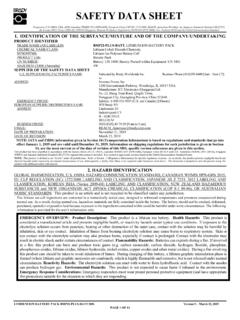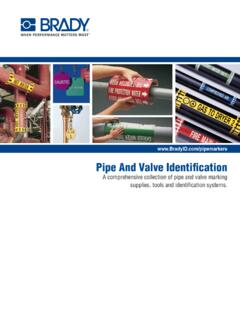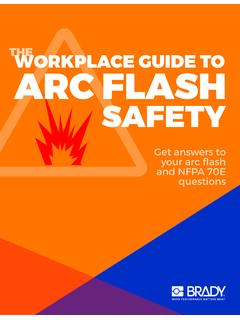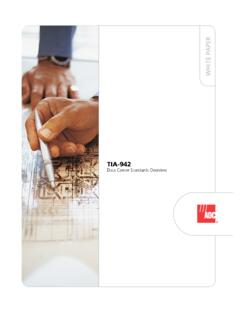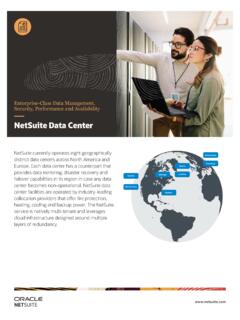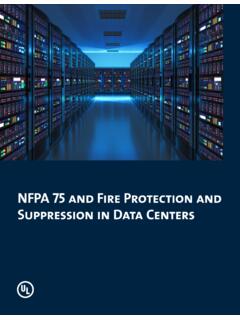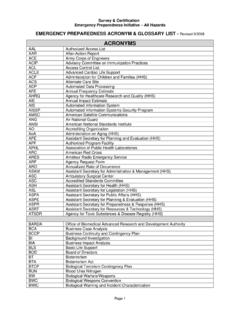Transcription of with the latest TIA-606-C labelling standard
1 Everything you need to know about complyingwith the latest TIA-606-C labelling standardCONTENTS2 03 Why use the latest labelling standards ? 05 A brief history of the TIA-606 standard 06 The latest standard : TIA-606-C 07 What s new in TIA-606-C ? 09 Why follow TIA 606-C? 11 How to properly identify cables according to TIA-606-C 12 How to make it easier to follow TIA 606-C: 12 6 features your handheld printer should have 14 Top 3 properties to look for in labels 16 Top 5 functions to look for in label software 17 What now?Why use the latest labelling standards ?Effective cable labelling helps you add value to your operations with organised installations that you can take pride in. Keeping up with best practices can benefit your company and your customers with increased efficiency, profitability and customer satisfaction. Properly labelled systems benefit all of us - installers and contractors, IT technicians, owners and data explosion - labelling has become far more important in recent years with the rise in data center growth and implementation of TIA labelling standards , including the latest TIA-606-C today, gone tomorrow - Network structure is never static and is always changing to keep up with new technology and increased bandwidth requirements.
2 Cables placed today will be replaced wireless world needs to be wired - As we move to a wireless world, the amount of cabling in facilities will increase as more devices are connected and dated systems are investment worth making - While labelling is only one part of a successful structured cabling or data center installation, it plays an important role in ensuring maximum uptime and audit compliance for your of data moving right now is generated by machines and building brief history of the TIA-606 labelling standardIn 2002, the Telecommunications Industry Association (TIA), which develops standards for the information and communications technology industry, set the first voluntary TIA-606-A standard . This established a minimum level of information that should be included on cable labels. It defined a labelling standard that maps a cable precisely to the floor, telecom room, and patch panel position or block position on which it s terminated. It included both colour-coded and alphanumeric guidelines for all networking and structured cabling components, which set it apart as a logical and sensible move to TIA-606-B.
3 In 2012, the TIA updated the standard to TIA-606-B, which included specifications for labelling and administrative best practices across all networked systems classes. It covered more facility classes of every size and type, from small office buildings to large commercial enterprises, corporate campuses and data centers, and added more granularity to identification locations within each of these facilities. In July 2017, the standard was updated to its current C revision. 6 The latest standard : TIA-606-C The TIA-606-C standard specifies administration systems for telecommunications infrastructure within buildings (including commercial, industrial, residential, and data center premises) and between buildings. This infrastructure may range in size from a building requiring a single telecommunication space (TS) and associated elements, to many TSs and associated elements in multiple campus locations. The standard applies to administration of telecommunications infrastructure in existing, renovated, and new coding Colour coding labels is recommended, but not required.
4 Compliant coding may be accomplished using colour labels or colour bands. 7 What s new in TIA-606-C ?Much of the TIA-606-B standard still applies within the TIA-606-C standard , but there are some new additions and D: Annex D provides additional guidelines for the administration of cabling supporting remote powering, including a cable bundle identifier scheme. It s an important development because it allows automatic infrastructure management systems from different manufacturers to work together. Changes to the identifier scheme for telecommunications grounding and bonding system elements: These changes specify the use of terms compatible with ISO/IEC 30129. Legacy terms used in versions of the TIA-607 standard earlier than revision C also will be s an important development because it allows automatic infrastructure management systems from different manufacturers to work schemes for telecommunications bonding and grounding system elements changed to align with TIA-607-C: BCT (bonding conductor for telecommunications) changed to TBC (telecommunications bonding conductor) RGB (rack grounding busbar) changed to RBB (rack bonding busbar) GE (grounding equalizer) changed to BBC (backbone bonding conductor) TGB (telecommunications grounding busbar) changed to SBB (secondary bonding busbar) TMGB (telecommunications main grounding busbar) changed to PBB (primary bonding busbar)Additional updates.
5 TIA-606-B-1 content replaced with a reference to TIA-5048 (adaption of ISO/IEC 18598) The preference for an ISO/IEC TR 14763-2-1 compatible format for new administration systems was removed Table summarising variables used in identifier formats added89 Why follow TIA-606-C ?Makes your job easier - Following the standard takes the guesswork out of creating labels in the office or on the your efficiency - Reduce time spent creating labels to streamline your entire installation and labelling practice - TIA-606-C is the industry standard , making the network easier to follow for your customer s current and future team mark of professionalism - Clear, durable labelling according to TIA-606-C standards is a sure sign of your experience and expertise. Ensures compliance with warranties - Some cable warranties are dependent upon successful labelling and documentation being turned in directly to the cable manufacturer as proof of system installation. Since cable warranties are a key factor in many buyers purchasing decisions, successfully certifying a system by supplying this type of information to the manufacturer is extremely important.
6 Improves record keeping - The standard requires you to link a record for each identifier that is printed on a label, allowing your customer to have a well-documented infrastructure that can be understood and managed by anyone responsible for making moves, adds or changes. Following the standard takes the guesswork out of creating labels in the office or on the customer satisfaction - Customers appreciate that their projects, whether large or small, are installed in full compliance with all applicable standards . From the building owner s perspective, a non-labeled plant becomes a liability because they can t get competent maintenance work done cost-effectively. It also reduces the time and cost associated with identifying and tracing a cable when problems occur or when a move, add or change is new business opportunities - Installers sometimes turn down repair and maintenance bids because cable tracing is labour-intensive and time-consuming. Adopting TIA-606-C standards makes it easier for you to bid competitively on future jobs when expansion occurs or maintenance is liability - Future maintenance workers can perform repairs, installation updates and upgrades in a safer, more secure way, with a reduced risk of human troubleshooting - Being able to identify information about cables quickly makes it faster and easier to troubleshoot can support you with any of your identification challenges.
7 Just contact us11 How to properly identify cables according to TIA-606-CEach of the following components must be clearly labelled with the appropriate identifiers: Telecommunications space data center room grid Racks and cabinets Patch panels Ports Cabling Pathways Work area outlets Grounding busbars Firestop locations BB13-42:06/KB13-41:06 Cabinet BB13 Cabinet KB13 Patch Panel at Rack Unit 42 Patch Panel at Rack Unit 41 Port 06 Port 06 LINK Identifier terminated in the same spacePatch Panel IdentificationCabinet BB13 Cabinet KB13 Patch Panel at Rack Unit 42 Patch Panel at Rack Unit 41 Ports 01-06 Ports 01-06toBB13-42 p 01-06 to KB13-41 p 01-061A - B01 Original LINK IdentifierFloor 1 Patch Panel BPort 1 Telecom Room Panel at Rack Unit 35 Horizontal Link IdentifierPort 8 Telecom Room 1 ALINK Identifier not terminated in the same spaceRack 112 How to make it easier to follow TIA-606-CChoosing the right handheld printer, labels and software can make it easy to create labels that follow TIA-606-C features your portable printer should have:1.
8 Wireless + Bluetooth connectivity - These capabilities allow you to set up and print labels from any location. You can create your own network, connect a laptop or tablet to your printer, and access data from file sets to print accurate labels in the field. 2. 300 DPI high-resolution printing - When you re printing 11-12 characters per line on a 2 label (51mm), you need high-resolution printing to make it legible. Look for a high DPI that will print labels with clear text, UPC codes, industry symbols and USB port - Import structured text data sets (such as .CSV files), lists and graphics from your laptop or tablet, which also reduces keying mistakes. You can also use it to plug in a full-size keyboard for bigger Built-in sequencers - Look for built-in macros so you can download and print custom or preformatted label templates, as well as run and print alphanumeric sequences. 5. Barcoding capabilities - Make sure this functionality is built into your printer s firmware so you can print bar codes and enable RFID tracking of assets and Cooperation with benchtop printers - Make sure your portables collaborate with your benchtop units so you can easily share data and files, and print on the FLOOR MARKING: 9 TIPSO ther features to look for: A large and well-lit screen for quick viewing and selection of labels Formatted label designs Easy-to-navigate menus Storage allowance and PC connectivity for downloading data Smart application keys with preformatted templates, for the types of labels needed for electrical, telecom, datacom, audio/video and security system work.
9 The capability to make both continuous labels and die-cut labels and automatic label setup, allowing the printer to automatically recognise the label part installed and default to the correct rotation, format, size and font when it is turned on Rechargeable NiMH batteries that allow printing more than 2,000 labels on a single charge Rugged construction Automatic smart font-sizing technology The ability to accept a variety of interchangeable tape cartridges to create different types of labelsWant all this and more? Check out the Brady BMP61 printer, our best handheld printer for efficient identification of wires, cables and how the printer works!14 Top 3 properties to look for in labels:1. Durability - Labels should be waterproof, tear resistant and scratch resistant, and stay attached over time. Ink should be just as rugged to remain legible over time, even in challenging The right stock - It s important to select a material that s made for your specific application and Easy to read - Choose the right sizes and colours so labels are easy to read on the wires you re installing.
10 Discover professional and reliable labels for cable & component identificationPantoneIndicationDescripti onOrange 150cDemarcation pointDemarcation point (central office termination)Green 353cNetwork connectionTermination of network connections on the customer side of the demarcation pointPurple 264cCommon equipmentTermination of cables originating from common equipment (pbx s, computers, lan s and multiplexers) white/silver in level backboneFirst level backbone telecommunications media termination in the building containing the main cross-connect (main cross-connect to tr or main cross-connect to local intermediate cross-connect). Purple in 422cSecond level backboneSecond level backbone telecommunications media termination in the building containing the main cross-connect (local intermediate cross-connect to tr). Purple (USA) or white (Canada) to identify second level backbone terminations in buildings not containing the main 291cHorizontal cablingTermination of station telecommunications media required only at the tr and equipment room end of the cable not at the telecommunications 465cInterbuilding backboneInterbuilding backbone cable terminations (main cross-connect to remote intermediate cross-connect)Yellow 101cAuxiliary & miscellaneous circuitsTermination of key telephone systemsRed 184c Key telephone systemsAreas that may expose employees to special physical or health hazards, risk of colliding with obstacles, of falling or of objects cable colour codesUsing colour-coded labels gives visual clues as to what the cables are used for and how they re connected to the panel or grid.
